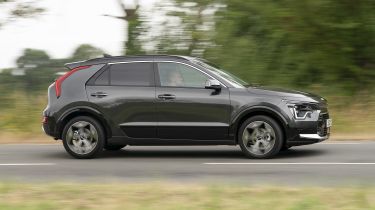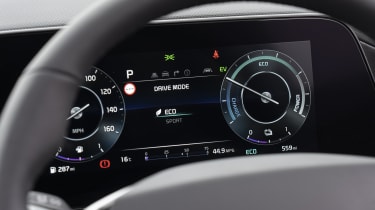Kia Niro review - MPG, CO2 and running costs
The Kia Niro offers a range of efficient electrified powertrains which should help to lower running costs
With prices for the entry-level Niro Hybrid currently starting at just under £30,000, not only does it sit in the same price range as the new Hyundai Kona Hybrid and other small SUVs, but hybrid-only hatchbacks like the Toyota Corolla and Honda Civic, too.
Kia has embraced electrification with quite some gusto, and like its predecessor, the Niro is available with the full gamut of electrified powertrains – full-hybrid, plug-in hybrid and pure-electric.
Kia says the base hybrid can return up to 64.2mpg on a combined cycle – about five miles-per-gallon better than the old model – but we averaged 50.5mpg after covering more than 11,000 in our Niro Hybrid long-term test car. That’s still decent for a car that you don’t plug in and we spent a lot of our time in the car on motorways. Plus, for comparison, the 11th-gen Civic we lived with only managed to achieve 45.1mpg after close to 6,000 miles of motoring. CO2 emissions are also better, with the Mk2 Niro Hybrid emitting 100-106g/km depending on which trim level you choose.
The Niro PHEV is more expensive to buy, but it’s also greener – emitting 23g/km of CO2 according to Kia – and can even achieve up to 353.1mpg on the WLTP combined test cycle. Figures like that sound very impressive, but you’ll need to charge the car regularly and drive on battery power as often as possible if you want to see close to those returns.
More reviews
Car group tests
- BYD Atto 3 vs Kia Niro EV 3: 2023 twin test review
- MG4 vs Kia Niro EV: 2022 twin test review
- Kia Niro vs Nissan Juke: 2022 twin test review
In-depth reviews
Long-term tests
Road tests
Used car tests
Even so, the lower CO2 emissions will make the Niro PHEV more appealing to company car drivers, but it can’t hold a candle to the Niro EV in this department. Because it doesn’t produce any tailpipe emissions, the Niro EV sits in the lowest possible Benefit-in-Kind (BiK) company-car tax bands, and is zero-rated for road tax (VED) and the London Congestion Charge until 2025, too.
Electric range, battery and charging
The plug-in hybrid Niro uses a 11.1kWh battery and offers a pure-electric driving range of up to 40 miles – or 38 miles if you upgrade to 3 or 4 spec. We expect closer to 30 miles of silent electric running is more achievable day-to-day, so long as you charge the car regularly. Kia says a 15 to 95 per cent charge takes close to three hours via a regular home wallbox charger.
The Niro EV features a 64.8kWh battery that offers a maximum range of 285 miles – just three miles further than the e-Niro could cover – but it’s competitive within the small electric SUV class at least. The Niro EV has also proved itself to be pretty efficient, returning 3.9 miler per kWh in our twin test against the MG4, which equates to a real-world range of 253 miles. A 10 to 80 per cent top-up from most rapid chargers takes at least 45 miles, while fully replenishing the Niro EV’s battery using a 7.2kW home wallbox will take about nine and a half hours.
Insurance groups
The cheapest Niro to insure is the regular hybrid model, sitting in groups 20 to 21. The plug-in hybrid sits in groups 23 to 24 and the Niro EV is in group 28 to 29. Whichever powertrain you choose, the insurance rating rises one group for the 3 and 4 trim levels over the base 2 spec.
You can get personalised car insurance quotes fast with our comparison tool powered by Quotezone...
Depreciation
Data from out car market experts indicates that the Niro family should hold onto around 57-59 per cent of their original list price after three years and 36,000 miles of ownership, with the plug-in hybrid performing the best, but not by much. Don't forget though, that the Niro PHEV and EV are more expensive to buy in the first place than the base hybrid model.
To get an accurate valuation on a specific model check out our valuation tool...








